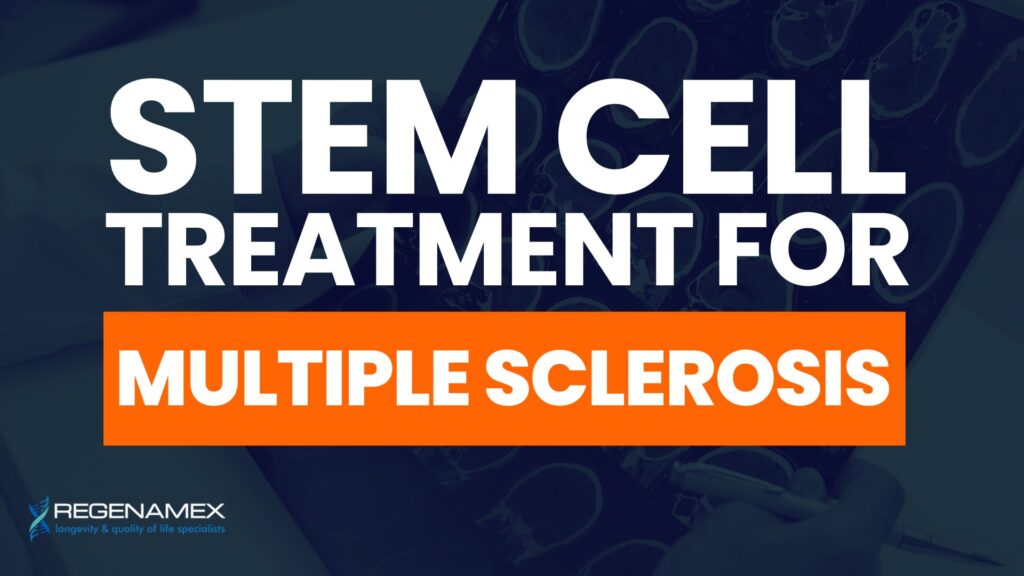
What Is Multiple Sclerosis Stem Cell Treatment and How Does It Work?
Multiple sclerosis stem cell treatment is a form of regenerative therapy that uses MSCs to help repair the neurological damage caused by multiple sclerosis (MS), an autoimmune condition in which the immune system attacks the protective myelin sheath surrounding nerve fibers in the central nervous system.
Mesenchymal stem cells from Wharton’s jelly offer a triple mechanism of action:
🧬 Immunomodulation: MSCs help reprogram the immune system, suppressing the abnormal autoimmune response that characterizes MS.
🔧 Neuroprotection and Remyelination: MSCs secrete trophic factors that protect nerve cells and may support the repair of damaged myelin.
💉 Anti-Inflammatory Effects: By reducing systemic and central nervous system inflammation, MSCs create a more favorable environment for neural recovery.
When injected into the bloodstream or administered intrathecally (into the spinal fluid), these cells migrate to areas of inflammation and damage, triggering your body’s natural healing mechanisms.
Who Benefits from Multiple Sclerosis Stem Cell Treatment?

People diagnosed with multiple sclerosis whether relapsing-remitting, primary progressive, or secondary progressive are increasingly turning to multiple sclerosis stem cell treatment as a viable alternative when traditional therapies no longer suffice. This regenerative option is particularly valuable for individuals who experience ongoing deterioration despite disease-modifying drugs or those seeking to avoid the long-term side effects of immunosuppressive medications. Mesenchymal stem cells (MSCs), especially those derived from Wharton’s jelly, have demonstrated the ability to recalibrate immune responses, reduce inflammation, and potentially even repair damaged neural tissue. At Regenamex, each patient undergoes a thorough evaluation to determine candidacy for treatment, ensuring a personalized approach that addresses their unique stage of disease and symptomatology. This makes it an ideal choice for patients who suffer from moderate to severe neurological disabilities, individuals facing rapid disease progression, and those for whom invasive procedures are not advisable.
The symptoms addressed by stem cell therapy are diverse and debilitating. Fatigue, one of the most commonly reported symptoms of MS, often improves with treatment as systemic inflammation is reduced. Muscle weakness and spasms may decrease, allowing for smoother movement and enhanced control. Many patients experience an improvement in their vision, particularly in cases of optic neuritis, as well as relief from tingling and numbness in their extremities. The therapy also offers hope to those struggling with coordination and balance, brain fog, or cognitive decline, symptoms that can severely impact day-to-day functioning. While this isn’t a cure, stem cell therapy offers real, tangible improvements that can dramatically shift quality of life. For a comprehensive look at how we assess and support each patient, visit our MS program page at Regenamex Multiple Sclerosis Treatment.
Results You Can Expect with Multiple Sclerosis Stem Cell Treatment

The potential benefits of multiple sclerosis stem cell treatment depend on several factors including how long a patient has had MS, the extent of neurological damage, and how early the regenerative intervention is initiated. At Regenamex, many patients report noticeable improvements within a few weeks, often starting with reduced fatigue, improved mood, and better energy levels. By the second or third month, additional improvements can include decreased spasticity, better coordination, and more clarity of thought—providing an overall sense of regained control over one’s body and mind. Around the 4 to 6-month mark, patients may experience enhanced mobility, improved bladder and bowel function, and in some cases, a slowing or even a halting of disease progression. While individual results vary, the regenerative nature of MSC therapy supports long-term stabilization and potential remyelination, offering an avenue of hope where previously only symptom management existed.
Scientific research supports these outcomes. A recent study published by the National Center for Biotechnology Information notes that MSC therapy may facilitate neuroprotective and anti-inflammatory effects that translate into clinical improvements for MS patients. These effects are believed to be due in part to MSCs’ secretion of growth factors and cytokines that aid neural repair, modulate immune response, and promote myelin restoration. With each step forward in clinical evidence, the case for stem cell therapy as a transformative option for MS continues to grow stronger. For anyone seeking in-depth knowledge about how stem cells benefit autoimmune neurological disorders, we recommend reading up on ongoing research at the National Multiple Sclerosis Society.
Why Mesenchymal Stem Cells from Wharton’s Jelly?

At Regenamex, we are deeply committed to delivering the most effective and ethical regenerative therapies possiblewhich is why we exclusively use mesenchymal stem cells from Wharton’s jelly in our protocols for multiple sclerosis stem cell treatment. Wharton’s jelly is the gelatinous tissue within the umbilical cord that is naturally rich in MSCs. These stem cells are young, highly potent, and immunoprivileged, meaning they pose a minimal risk of rejection. Unlike adult stem cells harvested from adipose tissue or bone marrow both of which involve invasive procedures and show reduced regenerative potential with age Wharton’s jelly-derived MSCs are harvested from donated, full-term placentas in a safe, ethical, and painless manner. Their youth and vitality translate into stronger paracrine signaling and better immunomodulatory functions, which are especially critical in reversing the chronic inflammatory cascade seen in MS.
These cells are known for their neuroregenerative capabilities, including their ability to support remyelination and preserve neuronal integrity. They release a sophisticated array of growth factors, exosomes, and cytokines that guide tissue healing, reduce oxidative stress, and signal the immune system to halt its self-destructive behavior. Moreover, because Wharton’s jelly cells are universally sourced, they are standardized, consistent, and uncontaminated by the degenerative effects of chronic illness or aging. At Regenamex, we never use adipose or bone marrow sources for these very reasons. If you’re curious about how our ethical sourcing and lab processing works, we encourage you to visit our full clinic overview at About Regenamex and see how we uphold international standards in every step of the process. For a general overview of MS symptoms and mechanisms, you can also refer to the Mayo Clinic’s guide on multiple sclerosis.
How the Treatment Is Performed

Every patient who undergoes multiple sclerosis stem cell treatment at Regenamex receives a custom-tailored protocol designed for optimal safety and maximum efficacy. The process begins with a detailed consultation and medical evaluation to assess the patient’s current condition, past treatments, and goals for recovery. Once eligibility is confirmed, a personalized plan is developed by our medical team. Treatment may include intravenous infusion of MSCs, local injections, or—in more advanced neurological cases—intrathecal (spinal) delivery to ensure the cells reach the central nervous system directly. Doses typically range from 1 million to 5 million cells per kilogram of body weight, depending on severity, with treatments spaced over several days.
Patients generally spend between 4 to 5 days at our facility in Mexico, during which they are closely monitored by our clinical staff. After the procedure, we provide comprehensive follow-up recommendations, including lifestyle adjustments, rehabilitation therapies, and supplements to enhance stem cell performance. Unlike traditional interventions, there is no extended hospital stay, and most patients can resume light activity within days. For international visitors, our concierge services help coordinate travel, lodging, and post-care so that your only focus is healing. We are proud to support patients from around the globe, offering world-class care at prices ranging from $2,500 to $12,000 USD, depending on the complexity of treatment. To explore more details about travel, logistics, and aftercare, visit our overview here: Stem Cell Therapy in Mexico.
Frequently Asked Questions About Multiple Sclerosis Stem Cell Treatment
Multiple sclerosis stem cell treatment is an advanced regenerative therapy designed to address the root causes of MS by calming the overactive immune system and promoting the repair of damaged nerve tissue. Using mesenchymal stem cells (MSCs) derived from Wharton’s jelly—an exceptionally potent and ethically sourced tissue from umbilical cords—this approach targets inflammation in the central nervous system and supports remyelination, the process of rebuilding the protective sheath around nerves. Once introduced into the body through intravenous or spinal injection, these MSCs home in on sites of damage, releasing bioactive molecules that help reduce autoimmunity, stimulate healing, and restore neurological function. The goal is not only symptom relief but long-term neurological protection and quality-of-life improvement.
Safety is one of the primary reasons why so many patients are choosing multiple sclerosis stem cell treatment at specialized clinics like Regenamex. The MSCs used are sourced from healthy, full-term births and processed under strict sterile conditions, ensuring a high level of purity and potency. Because Wharton’s jelly MSCs are immunoprivileged, they naturally avoid triggering immune rejection, eliminating the need for immunosuppressive drugs. Furthermore, when the therapy is administered by trained physicians in a licensed clinical setting, complications are extremely rare. Most patients tolerate the procedure very well, with only mild and temporary side effects such as slight fatigue or low-grade fever.
Improvements from multiple sclerosis stem cell treatment often begin to show gradually, as the body responds to the regenerative signals emitted by the infused stem cells. While some individuals notice subtle benefits within the first few weeks—such as increased energy, clearer cognition, or reduced muscle stiffness—more substantial changes typically emerge between the second and sixth month post-treatment. These may include better mobility, improved bladder and bowel control, decreased numbness or tingling, and even enhanced coordination and balance. It’s important to remember that healing timelines vary depending on how advanced the MS is and how well the body integrates the stem cell therapy, but many patients continue to experience improvement long after the initial procedure.
The cost of multiple sclerosis stem cell treatment at Regenamex in Mexico ranges between $2,500 and $12,000 USD. This price is influenced by several key factors, including the severity of the patient’s condition, the number of stem cells required for optimal effect, and whether the treatment includes intravenous, localized, or intrathecal (spinal) administration. Despite the comprehensive nature of the therapy and the high quality of Wharton’s jelly-derived MSCs used, Regenamex is able to offer competitive pricing thanks to lower overhead costs in Mexico compared to the U.S. or Europe. The clinic also provides full concierge support for international patients, adding further value for those traveling abroad for care.
Eligibility for multiple sclerosis stem cell treatment is determined after a detailed medical evaluation, but generally includes individuals who have received a confirmed diagnosis of MS and are experiencing symptoms such as fatigue, mobility issues, muscle spasms, or cognitive decline. Patients who have not responded well to conventional treatments, or who are experiencing disease progression despite medication, are often excellent candidates. Even those who have been living with MS for years may find benefit, depending on the extent of nerve damage and overall health. At Regenamex, the medical team thoroughly reviews each case to ensure that stem cell therapy is a safe and potentially effective option.
While stem cell therapy should not be seen as a direct replacement for all medications or surgical interventions, it can play a complementary or even transformational role in many patients' care plans. Multiple sclerosis stem cell treatment works by addressing the underlying causes of MS—namely, immune system imbalance and nerve damage—rather than merely suppressing symptoms. As a result, some patients are able to reduce their dependence on immunosuppressants, pain medications, or other long-term drugs. In cases where surgery is considered, particularly for mobility-related complications, stem cell therapy may offer a non-invasive alternative or delay the need for more aggressive interventions.

